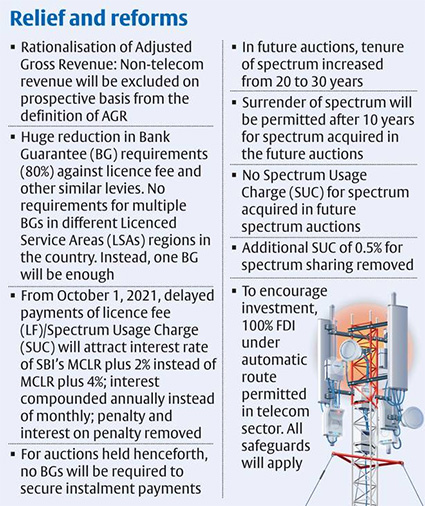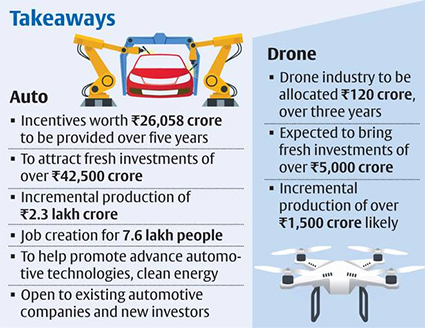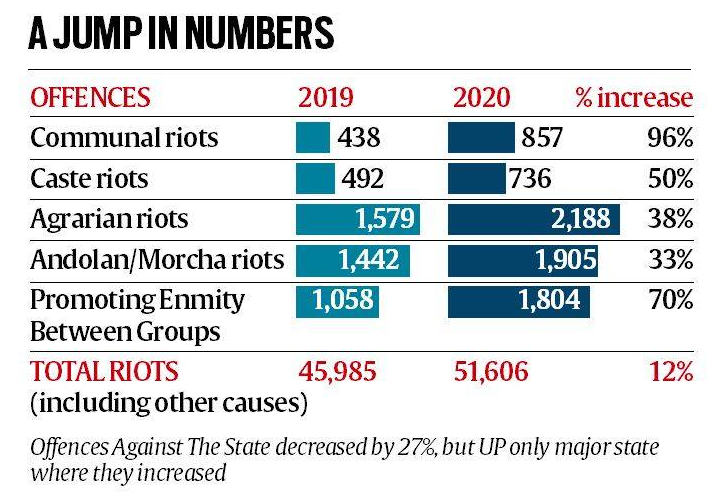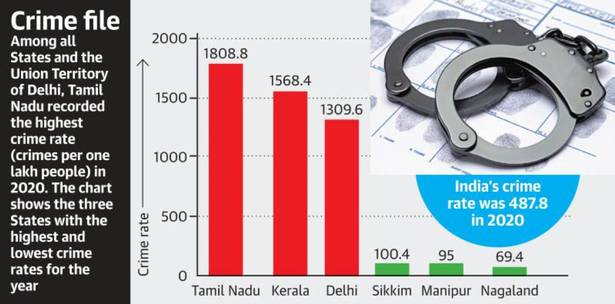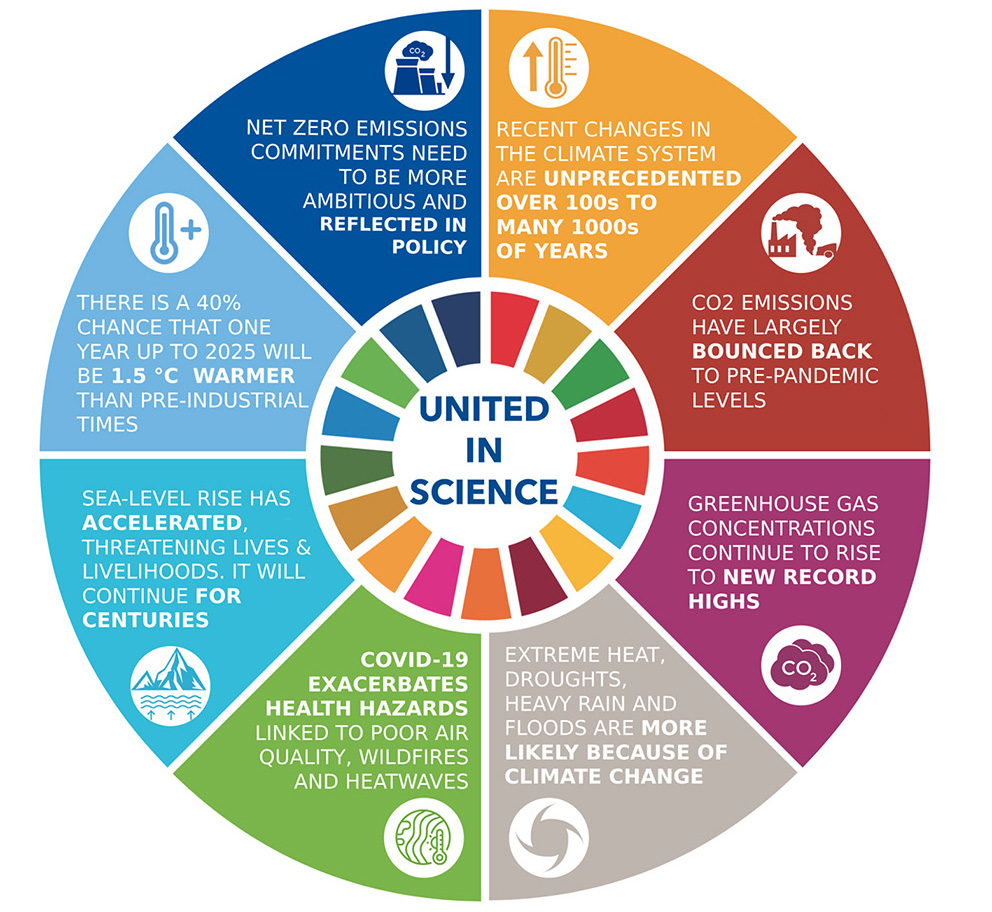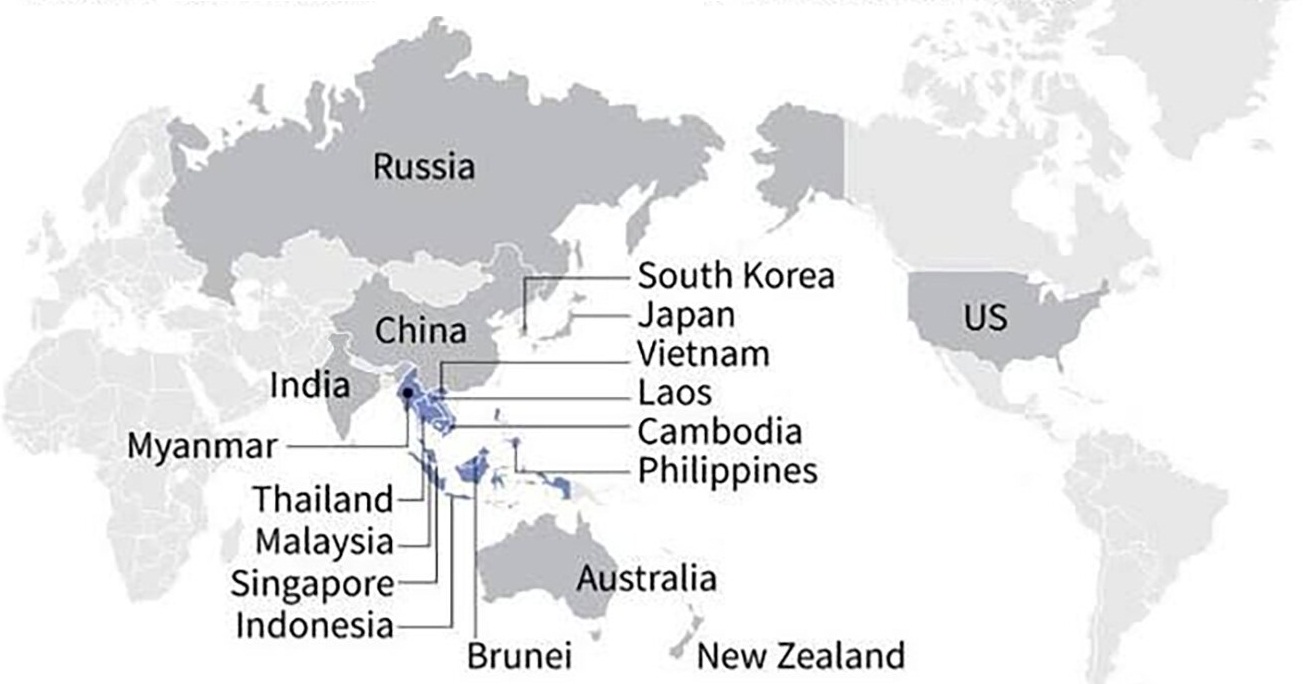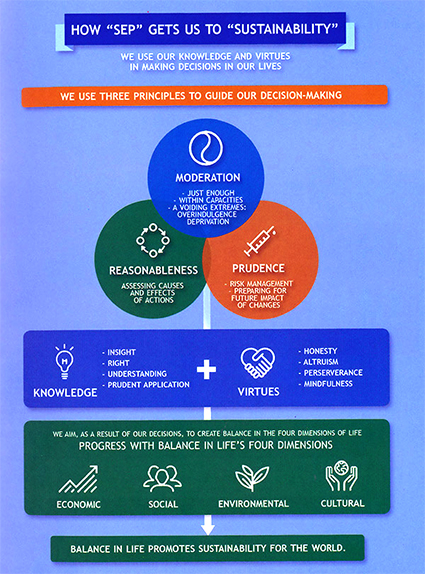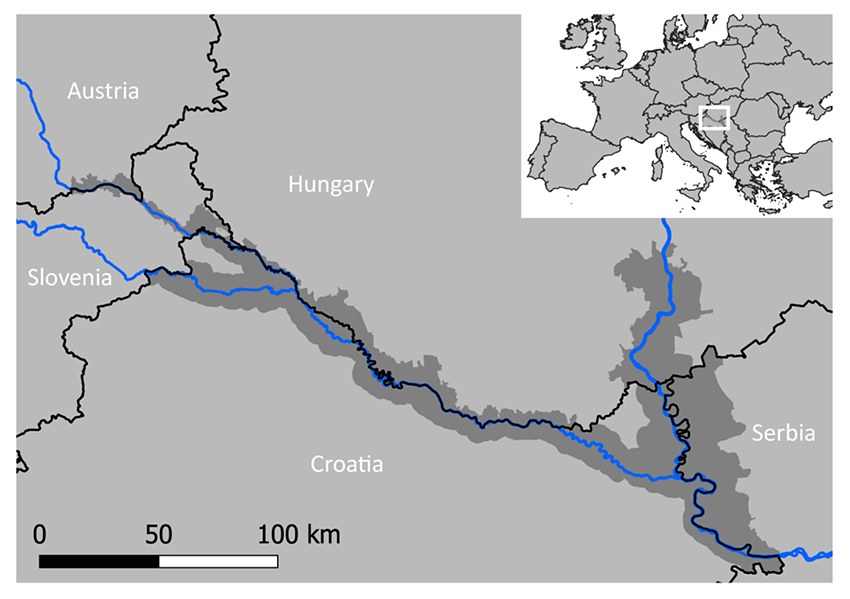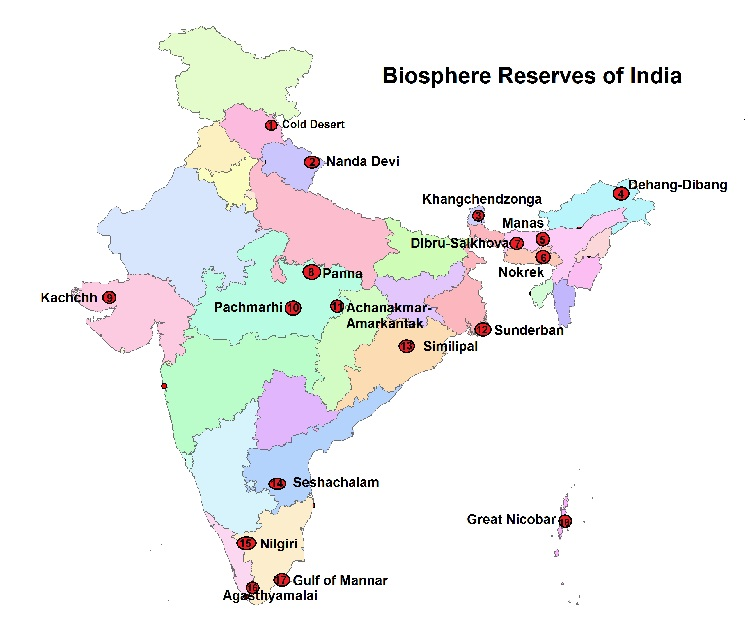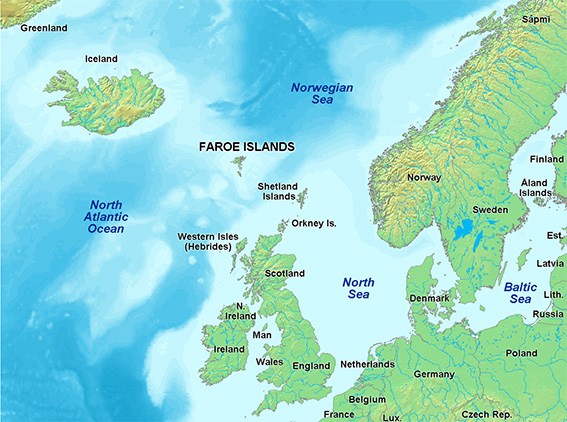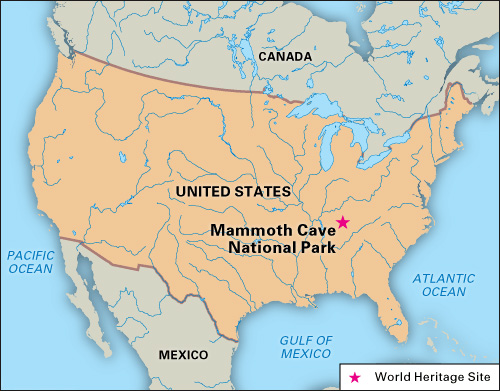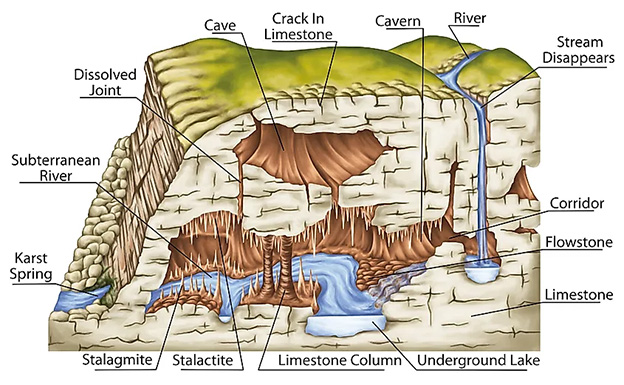Indian Economy
New Bad Bank Structure
Why in News
Recently, the Union Cabinet approved the Rs 30,600 crore guarantee to back Security Receipts issued by National Asset Reconstruction Company Limited (NARCL) for acquiring stressed loan assets.
- The NARCL is a part of a new Bad bank structure that was announced in the Budget 2021.
Key Points
- About the New Bad Bank Structure:
- For resolution of huge NPAs (Non-Performing Assets) in the Indian Banking sector, the government of India has set up two new entities to acquire stressed assets from banks and then sell them in the market.
- NPA refers to a classification for loans or advances that are in default or in arrears.
- NARCL: NARCL has been incorporated under the Companies Act and has applied to the Reserve Bank of India for a license as an Asset Reconstruction Company (ARC).
- NARCL will acquire stressed assets worth about Rs 2 lakh crore from various commercial banks in different phases.
- Public Sector Banks (PSBs) will maintain 51% ownership in NARCL.
- IDRCL: Another entity, India Debt Resolution Company Ltd (IDRCL), will then try to sell the stressed assets in the market.
- PSBs and Public Financial Institutes (FIs) will hold a maximum of 49% stake in IDRCL. The remaining 51% stake will be with private-sector lenders.
- The NARCL-IDRCL structure is the new bad bank structure.
- For resolution of huge NPAs (Non-Performing Assets) in the Indian Banking sector, the government of India has set up two new entities to acquire stressed assets from banks and then sell them in the market.
- Need for NARCL-IDRCL Structure:
- Existing ARCs have been helpful in the resolution of stressed assets, especially for smaller value loans.
- Various available resolution mechanisms, including Insolvency and Bankruptcy Code (IBC), have proved to be useful.
- However, considering the large stock of legacy NPAs, additional options/alternatives are needed and thus, the NARCL-IRDCL structure was announced in the Union Budget 2021.
- Working of NARCL-IDRCL and Guarantee Offered:
- The NARCL will first purchase bad loans from banks.
- It will pay 15% of the agreed price in cash and the remaining 85% will be in the form of “Security Receipts”.
- When the assets are sold, with the help of IDRCL, the commercial banks will be paid back the rest.
- If the bad bank is unable to sell the bad loan, or has to sell it at a loss, then the government guarantee will be invoked.
- The difference between what the commercial bank was supposed to get and what the bad bank was able to raise will be paid from the Rs 30,600 crore that has been provided by the government.
- This guarantee is extended for a period of five years.
Note
- Security receipts are defined under section 2(1) (zg) of SARFAESI Act.
- It means a receipt or other security, issued by an asset reconstruction company to any qualified buyer pursuant to a scheme, evidencing the purchase or acquisition by the holder, thereof, of an undivided right, title or interest in the financial asset involved in securitization.
Bad Bank
- About:
- The bad bank is an Asset Reconstruction Company (ARC) or an Asset Management Company (AMC) that takes over the bad loans of commercial banks, manages them and finally recovers the money over a period of time.
- The bad bank is not involved in lending and taking deposits, but helps commercial banks clean up their balance sheets and resolve bad loans.
- The takeover of bad loans is normally below the book value of the loan and the bad bank tries to recover as much as possible subsequently.
- Effect of Bad Bank:
- Commercial Banks’ Perspective: Commercial banks are saddled with high NPA levels, setting up of the Bad bank will help.
- That’s because such a bank will get rid of all its toxic assets, which were reducing its profits, in one quick move.
- When the recovery money is paid back, it will further improve the bank’s position. Meanwhile, it can start lending again.
- Government and Taxpayer Perspective: Whether it is recapitalising PSBs laden with bad loans or giving guarantees for security receipts, the money is coming from the taxpayers’ pocket.
- While recapitalisation and such guarantees are often designated as “reforms”, they are band aids at best.
- The only sustainable solution is to improve the lending operation in PSBs.
- The plan of bailing out commercial banks will collapse if the bad bank is unable to sell such impaired assets in the market. The burden indeed will fall upon the taxpayer.
- Commercial Banks’ Perspective: Commercial banks are saddled with high NPA levels, setting up of the Bad bank will help.
Way Forward
- So long as Public Sector Banks’ managements remain beholden to politicians and bureaucrats, their deficit in professionalism will remain and subsequently, prudential norms in lending will continue to suffer.
- Therefore, a bad bank is a good idea, but the main challenge lies with tackling the underlying structural problems in the banking system and announcing reforms accordingly.
Indian Economy
Reforms in Telecom Sector
Why in News
Recently, the Union Cabinet has approved a number of structural and process reforms in the Telecom sector.
- These reforms include a redefinition of the much-litigated concept of Adjusted Gross Revenue (AGR), a four-year moratorium on Telecom Service Providers' (TSPs) dues to the government, among others.
Key Points
- About the Reforms:
- Spectrum Related Reforms: Spectrum auctions will be normally held in the last quarter of every financial year (fixed calendar).
- The future spectrum auctions will be done for a period of 30 years instead of the current 20 years.
- A telco will be allowed to surrender its spectrum after completing a 10-year lock-in period from the date of purchase.
- Spectrum sharing is being encouraged and the additional SUC (Spectrum Usage Charges) of 0.5% for spectrum sharing is removed.
- Spectrum relates to the radio frequencies allocated to the mobile industry and other sectors for communication over the airwaves.
- Rationalization of AGR:
- AGR was previously interpreted as being based on all revenue, rather than just that associated with a company’s core telecom business.
- The government has accepted that this interpretation was problematic, which will reduce the future financial burden on companies.
- Telecom companies have to pay a pre-fixed percentage of AGR (excluding non-telecom revenues) to the government as statutory levies but this will apply prospectively.
- Moratorium on AGR Dues: The earlier definition of AGR, backed by the Telecom Department and upheld by the Supreme Court in 2019, had made telcos liable to pay Rs. 1.6 lakh crore.
- This payment has cash-strapped the telecom sector, which led to the losses of business to telecom companies like Vodafone and established a duopoly (reliance Jio and Bharti Airtel).
- In order to revive the telecom sector, a four-year moratorium on all spectrum and AGR dues has been approved.
- However, those TSPs opting for the moratorium will be required to pay interest on the amount availed under the benefit.
- Interest Rates Rationalized and Penalties Removed:
- The interest which is compounded monthly on the Spectrum Usage Charges (SUC) will now be compounded annually and also the interest rate will be lowered, based on MCLR + 2% instead of MCLR + 4%.
- MCLR refers to the lowest lending rate banks are permitted to offer - the Marginal Cost of funds-based Lending Rate.
- Additionally, the penalty and interest on penalty stand removed.
- The interest which is compounded monthly on the Spectrum Usage Charges (SUC) will now be compounded annually and also the interest rate will be lowered, based on MCLR + 2% instead of MCLR + 4%.
- FDI Reforms: Foreign Direct Investment (FDI) in the sector has also been allowed up to 100% under the automatic route, from the existing limit of 49%.
- Spectrum Related Reforms: Spectrum auctions will be normally held in the last quarter of every financial year (fixed calendar).
Adjusted Gross Revenue
- AGR is a fee-sharing mechanism between the government and the telcos who shifted to the 'revenue-sharing fee' model in 1999, from the 'fixed license fee' model.
- In this course, telcos are supposed to share a percentage of AGR with the government.
- Under this, mobile telephone operators were required to share a percentage of their AGR with the government as annual License Fee (LF) and Spectrum Usage Charges (SUC).
- In 2005, Cellular Operators Association of India (COAI) challenged the government’s definition for AGR calculation.
- The companies claimed that AGR should comprise just the revenue accrued from core services and not dividend, interest income or profit on the sale of any investment or fixed assets.
- The Supreme Court upheld the definition of AGR as stipulated by the DoT (revenues from both telecom and non-telecom services) in October 2019.
- Significance of these Reforms:
- Reviving Competition: Four years’ Moratorium would encourage companies to invest in customer service and new technology.
- Promoting Ease of Doing Business: The allowance of 100% FDI in the sector (through the automatic route) came shortly after the government decided to scrap a controversial retrospective tax.
- Together, these signal the return to an investor-friendly climate.
- Promoting Digital India: The telecom sector is one of the prime movers of the economy and the measures announced by the government would enable the industry to achieve the goals of Digital India.
- Further Technological Advancement: Together, these measures would pave the way for large scale investments into the sector, including for 5G technology deployment, and generate more jobs.
Way Forward
Moratorium on AGR dues and spectrum dues would only provide temporary relief with these deferred dues to be payable eventually with interest. Thus, all the stakeholders involved should find a way to develop a sustainable tariff policy.
Indian Economy
PLI Scheme for Auto & Drone Sector
Why in News
Recently, the Union Cabinet approved a Rs. 26,058 crore Production Linked Incentive (PLI) scheme for auto, auto-components and Drone industries to enhance India’s manufacturing capabilities.
- The scheme for the sector is part of the overall production-linked incentives announced for 13 sectors in the Union Budget 2021-22 with an outlay of Rs 1.97 lakh crore.
- It is a significant milestone in India’s journey towards ‘Atma Nirbharta’ and will enable the country to join the top order of Auto and Drone manufacturing nations.
Key Points
- PLI Scheme:
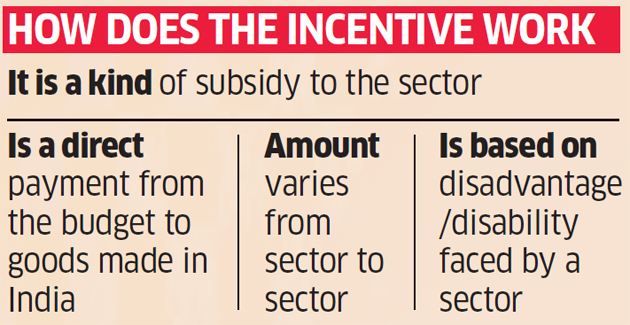
- PLI scheme, introduced in March 2020, aims to give companies incentives on incremental sales from products manufactured in domestic units.
- Apart from inviting foreign companies to set shop in India, it also aims to encourage local companies to set up or expand existing manufacturing units.
- It has also been approved for sectors such as automobiles, pharmaceuticals, IT hardware including laptops, mobile phones & telecom equipment, white goods, chemical cells, food processing, Textile Sector etc.
- PLI for Auto Sector:
- About:
- It excludes conventional petrol, diesel and CNG segments (Internal Combustion Engine) since it has sufficient capacity in India.
- It is incentivizing only advanced automotive technologies or auto components whose supply chains are weak, dormant, or non-existing.
- It is aimed at boosting new technology and the economy of clean fuels.
- Components:
- Champion OEM (Original Equipment Manufacturers) Scheme:
- It is a sales value linked plan, applicable to Battery Electric and Hydrogen Fuel Cell Vehicles of all segments.
- Champion Incentive Scheme:
- It is a Sales Value Linked plan for advanced technology components, Complete and Semi-Knocked Down (CKD/SKD) kits, vehicle aggregates of 2-wheelers, 3-wheelers, passenger vehicles, commercial vehicles and tractors.
- Champion OEM (Original Equipment Manufacturers) Scheme:
- Significance:
- This scheme along with the already launched PLI for Advanced Chemistry Cell and Faster Adoption of Manufacturing of Electric Vehicles (FAME) Scheme will give a big boost to the manufacture of Electric Vehicles.
- It will contribute towards reducing carbon emissions and oil imports.
- It will encourage production of auto components using advanced technologies that will boost localisation, domestic manufacturing and also attract foreign investments.
- It will help setting up new facilities and create more jobs. It is expected to generate 7.5 lakh jobs for the auto sector.
- About:
- PLI for Drone Sector:
- About:
- It covers a wide variety of drone components, including airframe, propulsion systems, power systems, batteries, inertial measurement unit, flight control module, ground control station, communication systems, cameras, sensors, spraying systems, emergency recovery system, and trackers.
- It is expected to bring fresh investments of over Rs 5,000 crore and incremental production of over Rs 1,500 crore and create additional employment of about 10,000 jobs.
- Significance:
- It will encourage entrepreneurs to strive towards building drones, components, and software for the global market. It will also open many more verticals for the utilisation of drones.
- It will help reduce imports. At present 90 %of the drones in India are imported.
- The government intends to make India into a global drone hub by 2030.
- About:
Internal Security
Crime in India Report 2020: NCRB
Why in News
Recently, National Crime Records Bureau (NCRB) released the Crime in India Report 2020.
- While 2020, a year marked by months of a national lockdown due to the pandemic saw fewer traditional crimes such as those committed against women and children, among others, it witnessed a big spike in civil conflicts.
Key Points
- Riots (Civil Conflicts):
- Communal riots registered an increase of 96% in 2020 over the previous year.
- Delhi Police alone registered the highest i.e. 520 cases of communal riots in the year and Uttar Pradesh (UP) did not record a single case of communal violence in 2020.
- Caste riots saw an increase of close to 50%, agrarian riots 38% and riots during ‘andolan/morcha’ increased by 33%.
- Communal riots registered an increase of 96% in 2020 over the previous year.
- Traditional Crimes:
- The number of cases registered for crimes against women, children and senior citizens, theft, burglary, robbery and dacoity, among others, dropped by about 2 lakh.
- Murder registered a marginal increase of 1% even as offences falling under the category of “violent crimes” decreased by 0.5%.
- Delhi is the most unsafe city for women. More than 10,093 cases of crimes against women were registered in the capital in 2020.
- Environment Related Offences:
- Cases under the ‘environment-related offences’ category increased by 78.1% in the country in 2020.
- Cyber Crime:
- The rate of cyber crime (incidents per lakh population) also increased from 3.3% in 2019 to 3.7% in 2020.
- Offences Against State:
- The year also saw a significant drop in cases related to Offences against the State, with a drop of 27% over 2019.
- UP, however, was the only major state to record an increase in this category, mostly due to the large number of ‘Damage to Public Property’ cases registered by the state, many of them during the anti- CAA (Citizenship (Amendment) Act, 2019) protests.
- Offences against the State’ include cases related to sedition and waging war against the nation, those falling under provisions of the Unlawful Activities Prevention Act (UAPA) 1967, Official Secrets Act 1923 and Damage to Public Property Act 1954.
- State Wise Data:
National Crime Records Bureau
- NCRB, headquartered in New Delhi, was set-up in 1986 under the Ministry of Home Affairs to function as a repository of information on crime and criminals so as to assist the investigators in linking crime to the perpetrators.
- It was set up based on the recommendations of the National Police Commission (1977-1981) and the MHA’s Task Force (1985).
- NCRB brings out the annual comprehensive statistics of crime across the country (‘Crime in India’ report).
- Having been published since 1953, the report serves as a crucial tool in understanding the law and order situation across the country.
- The inaugural function of the 2nd CCTNS Hackathon and Cyber Challenge 2020-21 of NCRB was held in New Delhi.
Biodiversity & Environment
United in Science 2021: WMO
Why in News
Recently, the World Meteorological Organization (WMO) released a report named United in Science 2021.
- It is a multi-organization high-level compilation of the latest climate science information.
- The report is coordinated by the WMO, with inputs from the United Nations Environment Programme, World Health Organization, Intergovernmental Panel on Climate Change, Global Carbon Project, World Climate Research Programme and the Met Office (UK).
Key points
- Climate Change:
- The pace of climate change has not been slowed by the global Covid-19 pandemic and the world remains behind in its battle to cut carbon emissions.
- It has caused only a temporary downturn in carbon dioxide (CO2) emissions in 2020.
- High latitude regions and the Sahel are likely to be wetter over 2021–2025, than the recent past.
- Reduction targets are not being met and there is a rising likelihood the world will miss its Paris Agreement target of reducing global warming to 1.5 degrees Celsius above pre-industrial levels.
- There is an increasing likelihood that temperatures would temporarily breach the threshold of 1.5 degrees Celsius above the pre-industrial era, in the next five years.
- The pace of climate change has not been slowed by the global Covid-19 pandemic and the world remains behind in its battle to cut carbon emissions.
- Temperature:
- Average global temperature for the past five years was among the highest on record.
- Rising global temperatures are fuelling devastating extreme weather throughout the world, with spiralling impacts on economies and societies.
- Climate hazards such as heatwaves, wildfires and poor air quality combine to threaten human health worldwide, putting vulnerable populations at particular risk.
- Greenhouse Gases:
- Concentrations of major greenhouse gases in the atmosphere continued to increase last year and during the first half of 2021.
- Fossil Fuel Emissions:
- Fossil fuel emissions from coal, gas, cement, etc were back to 2019 levels or even higher in 2021.
- Sea Level:
- Global mean sea levels rose 20 cm from 1900 to 2018. Even if emissions are reduced to limit warming to well below 2°C, global mean sea level would likely rise by 0.3-0.6 m by 2100, and could rise 0.3-3.1 m by 2300.
- Loss of Work Hours:
- An excess of 103 billion potential work hours were lost globally in 2019, compared to 2000.
- It was due to heat-related mortality and work impairment, caused by rising temperatures.
- An excess of 103 billion potential work hours were lost globally in 2019, compared to 2000.
- Suggestions:
- More countries should develop long-term strategies that are consistent with the 2015 Paris Agreement.
- Net-zero commitments needed to be translated into strong near-term policies and action.
- Adaptation strategies are needed where they do not exist – especially in low-lying coasts, small islands, deltas and coastal cities.
- Covid-19 recovery efforts should be aligned with national climate change and air quality strategies to reduce risks from compounding and cascading climate hazards, and gain health co-benefits.
Way Forward
- World needs a breakthrough on protecting people and their livelihoods, with at least half of all public climate finance committed to building resilience and helping people adapt.
- And it needs much greater solidarity, including full delivery of the long-standing climate finance pledge to help developing countries take climate action.
International Relations
15th East Asia Summit Energy Ministers Meeting
Why in News
Recently, the Union Minister of State for Power attended the 15th East Asia Summit Energy Ministers Meeting.
- The theme of the meeting was “We Care, We Prepare, We Prosper”.
Key Points
- About the Meeting:
- The meeting was aimed at coordinating efforts of Association of Southeast Asian Nations (ASEAN) countries in pursuing the goal of energy security and energy transition that will benefit the people of the region.
- India confirmed that ASEAN is a region of great importance and engagement with ASEAN has been, and will remain, a critical element of India’s ‘Act East’ policy and strategy.
- Acting East is now a central element in India's Indo-Pacific vision.
- A brief status of the Indian energy transition plans, policies, challenges and efforts towards decarbonisation was also provided.
- Some of India’s initiatives include National Solar Mission (NSM), Pradhan Mantri Ujjwala Yojana (PMUY), Unnat Jyoti by Affordable LEDs for All (UJALA), Smart City Mission (SCM), etc.
- East Asia Summit:
- About:
- Established in 2005, it is a forum of 18 regional leaders for strategic dialogue and cooperation on the key political, security, and economic challenges facing the Indo-Pacific region.
- The concept of an East Asia Grouping was first promoted in 1991 by the then Malaysian Prime Minister, Mahathir bin Mohamad.
- There are six priority areas of regional cooperation within the framework of the EAS. These are – Environment and Energy, Education, Finance, Global Health Issues and Pandemic Diseases, Natural Disaster Management, and ASEAN Connectivity.
- Membership:
- It comprises the ten member states of the ASEAN which are Brunei, Cambodia, Indonesia, Laos, Malaysia, Myanmar, the Philippines, Singapore, Thailand, and Vietnam, along with 8 other countries namely Australia, China, Japan, India, New Zealand, the Republic of Korea, Russia and the USA.
- It is an ASEAN-centred forum so it can only be chaired by an ASEAN member.
- Brunei Darussalam is the chair for 2021.
- EAS Meetings and Processes:
- The EAS calendar culminates in the annual Leaders' Summit, which is usually held alongside ASEAN Leaders' meetings in the fourth quarter of every year.
- Meetings of EAS Foreign Ministers and Economic Ministers are also held annually.
- India and EAS:
- India is one of the founding members of the East Asia Summit.
- At the East Asia Summit in Bangkok in November 2019, India had unveiled India’s Indo-Pacific Oceans Initiative (IPOI), which is aimed at forging partnerships to create a secure and stable maritime domain.
- About:
- Other Related Groupings:
- ASEAN Defence Ministers Meeting (ADMM) Plus:
- It is an annual meeting of Defence Ministers of 10 ASEAN countries and eight dialogue partner countries.
- The ADMM-Plus countries include ten ASEAN Member States and eight Plus countries, namely Australia, China, India, Japan, New Zealand, Republic of Korea, Russian Federation, and the United States (same as in the EAS).
- ASEAN Regional Forum:
- Established in 1994, the ASEAN Regional Forum (ARF) is an important platform for security dialogue in the Indo-Pacific.
- It comprises 27 members: the 10 ASEAN member states, the 10 ASEAN dialogue partners (Australia, Canada, China, the European Union, India, Japan, New Zealand, the Republic of Korea (ROK), Russia and the United States); Bangladesh, the Democratic People's Republic of Korea, Mongolia, Pakistan, Sri Lanka, and Timor-Leste; and one ASEAN observer (Papua New Guinea).
- ASEAN Defence Ministers Meeting (ADMM) Plus:
Economy
Sufficiency Economy Philosophy: Thailand
Why in News
Thailand believes that its homegrown development approach of Sufficiency Economy Philosophy (SEP) can serve as an alternative approach to achieving the Sustainable Development Goals (SDGs).
- In 2020, Indian PM announced Atmanirbhar Bharat or Self-reliant India Movement, which has a similar approach to make India and its citizens independent and self-reliant in all senses. When India speaks of self-reliance, it does not advocate for a self-centered system, there is also a concern for the whole world’s happiness, cooperation and peace.
Key points
- About:
- It is an innovative approach to development designed for practical application over a wide range of problems and situations.
- It is also part of the fundamental administration policy of the state (Thailand).
- It was introduced in Thailand after the Asian financial crisis in 1997.
- It is a philosophy that guides one’s inner thinking to immunize oneself from external shocks and can be applied in any setting and at any levels.
- It is an innovative approach to development designed for practical application over a wide range of problems and situations.
- Levels:
- Individual and Family Level: It means living a simple life, living within one's means, and refraining from taking advantage of other people.
- Community Level: It involves joining together to participate in decision-making, developing mutually-beneficial knowledge, and appropriately applying technology.
- National Level: It postulates a holistic approach with an emphasis upon appropriateness, competitive advantage, low risk, and avoiding over-investment.
- It involves keeping abreast with what is happening elsewhere in the world, hedging investments, and reducing imports and over dependence on other countries.
- Pillars:
- Knowledge: It enables effective planning and execution of developmental activities.
- Ethics and Values: It enhances human development by emphasizing honesty, altruism, and perseverance, with creating active, engaged citizens, and promoting good governance as the ultimate goal.
- Principles:
- Moderation: It entails producing and consuming within one’s capacity and avoiding overindulgence.
- Reasonableness: It is using one’s mental faculties to examine the causes and consequences of actions on one’s well-being, household and community.
- Prudence: It refers to risk management in order to be prepared for impacts from any disruptions.
Biodiversity & Environment
World’s First ‘Five-Country Biosphere Reserve’
Why in News
Recently, Mura-Drava-Danube (MDD) was declared as the world’s first ‘five-country biosphere reserve’ by the United Nations Educational, Scientific and Cultural Organization (UNESCO).
Key Points
- About MDD:
- The biosphere reserve covers 700 kilometres of the Mura, Drava and Danube rivers and stretches across Austria, Slovenia, Croatia, Hungary and Serbia.
- The total area of the reserve is a million hectares - in the so-called ‘Amazon of Europe’, which is now the largest riverine protected area in Europe.
- The biosphere “represented an important contribution to the European Green Deal (climate action plan) and contributed to the implementation of the EU Biodiversity Strategy in the Mura-Drava-Danube region.”
- The strategy’s aim is to revitalise 25,000 km of rivers and protect 30% of the European Union’s land area by 2030.
- Importance of the MDD:
- The area is one of the richest in Europe in terms of species diversity.
- It is home to floodplain forests, gravel and sand banks, river islands, oxbows and meadows.
- The area is home to the highest density in Europe of breeding pairs of white-tailed eagle and endangered species such as the little tern, black stork, otters, beavers and sturgeons.
- It is also an important stepping stone for more than 2,50,000 migratory waterfowls every year.
Biosphere Reserve (BR)
- About:
- BR is an international designation by (UNESCO) for representative parts of natural and cultural landscapes extending over large areas of terrestrial or coastal/marine ecosystems or a combination of both.
- BR tries to balance economic and social development and maintenance of associated cultural values along with the preservation of nature.
- BRs are nominated by national governments and remain under the sovereign jurisdiction of the states where they are located.
- These are designated under the intergovernmental MAB Programme by the Director-General of UNESCO following the decisions of the MAB International Coordinating Council (MAB ICC).
- The Man and the Biosphere (MAB) Programme is an intergovernmental scientific programme that aims to establish a scientific basis for enhancing the relationship between people and their environments.
- Their status is internationally recognized.
- There are 727 biosphere reserves in 131 countries, including 22 transboundary sites.
- Three Main Zones:
- Core Areas: It comprises a strictly protected zone that contributes to the conservation of landscapes, ecosystems, species and genetic variation.
- Buffer Zones: It surrounds or adjoins the core area(s), and is used for activities compatible with sound ecological practices that can reinforce scientific research, monitoring, training and education.
- Transition Area: The transition area is where communities foster socio-culturally and ecologically sustainable economic and human activities.
- Biosphere Reserves in India:
- Presently, there are 18 Biosphere Reserves in India, among which 12 Biosphere reserves in India find their place in UNESCO’s List of Man & Biosphere Reserves Programme.
- The latest included under the MAB was ‘Panna Biosphere Reserve’ (Madhya Pradesh).
- Presently, there are 18 Biosphere Reserves in India, among which 12 Biosphere reserves in India find their place in UNESCO’s List of Man & Biosphere Reserves Programme.
Important Facts For Prelims
Killing of White-Sided Dolphins: Faroe Islands
Why in News
Recently, the traditional annual killing of whales and dolphins (grindadrap” hunt) in North Atlantic islands that belong to Denmark has sparked controversy.
- 1,428 white-sided dolphins were slaughtered at Faroe Islands.
Key Points
- White-Sided Dolphins:
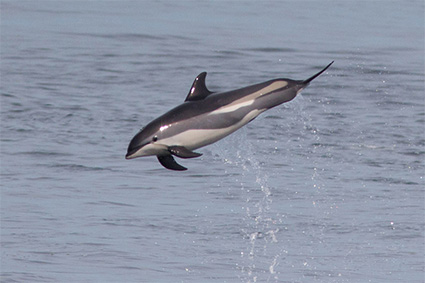
- Scientific Name: Lagenorhynchus acutus
- Characteristics:
- Their common name comes from the prominent white stripes on their sides, which span from below the dorsal fin to their tail, where it turns into a yellow or amber color.
- Their scientific name comes from the Greek word lagenos (which means bottle), rhynchus (which means snout or nose), and acutus from Latin (which means sharp or pointed, referring to their sharply-pointed dorsal fins).
- Habitat:
- The distribution of the Atlantic white-sided dolphin is the cool temperate and subarctic waters of the north Atlantic Ocean from southern Greenland to Massachusetts, and from the British Isles to western Norway.
- It has also been reported as far as the southern Barents Sea, the Baltic Sea, the Azores, and the Adriatic Sea.
- Conservation Status:
- Dolphins in Indian Waters:
Important Facts For Prelims
Mammoth Cave: US
Why in News
Recently, the official length of Mammoth Cave has been extended to 420 miles.
Key Points
- The additional mileage (8 miles) was mapped and documented by the Cave Research Foundation.
- Mammoth Cave National Park, located in the state of Kentucky (US), has the world's largest network of natural caves and underground passageways, which are characteristic examples of limestone formations (karst topography).
- It is a World Heritage Site (designated in 1981).
- It became an International Biosphere Reserve in 1990.
Karst Topography
- It is a type of landscape where the dissolving of the bedrock has created sinkholes, sinking streams, caves, springs, and other characteristic features.
- Karst is associated with soluble rock types such as limestone, marble, and gypsum.
- In general, a typical karst landscape forms when much of the water falling on the surface interacts with and enters the subsurface through cracks, fractures, and holes that have been dissolved into the bedrock.
- After traveling underground, sometimes for long distances, this water is then discharged from springs, many of which are cave entrances.

